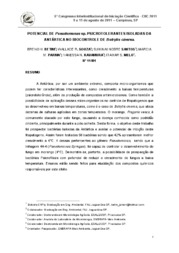Potencial de Pseudomonas sp. psicrotolerantes isoladas da Antártica no biocontrole de Botrytis cinerea.
Potencial de Pseudomonas sp. psicrotolerantes isoladas da Antártica no biocontrole de Botrytis cinerea.
Author(s): BETIM, B. H.; SOUZA, W. R.; SANTOS, S. N.; PARMA, M. M.; KAVAMURA, V. N.; MELO, I. S. de
Summary: Resumo: A Antártica, por ser um ambiente extremo, comporta micro-organismos que podem ter características interessantes, como crescimento a baixas temperaturas (psicrotolerância), além da produção de compostos antimicrobianos. Como também a possibilidade de aplicação desses micro-organismos no controle de fitopatogenos que se desenvolveu em baixas temperaturas, como é o caso de Botrytis cinerea, que ataca dezenas de culturas agrícolas em zonas temperadas. O morango, Fragaria vesca, é comumente atacado por este fungo, causando a doença conhecida como podridão cinzenta, principalmente durante a pós-colheita. Desta forma, o objetivo deste trabalho foi prospectar bactérias isoladas da Antártica e avaliar o potencial de inibição deste fitopatogeno. Assim foram testadas 56 bactérias sendo que 42% apresentaram melhor crescimento a 4°C. 4 dessas pertencentes ao gênero Pseudomonas, sendo que a linhagem 44-4 (Pseudomonas Syringae), foi capaz de controlar o desenvolvimento do fungo em morango (4°C). Demonstra-se, portanto, a possibilidade de prospecção de bactérias Psicrofilicas com potencial de reduzir o crescimento de fungos a baixa temperatura. Ensaios estão sendo feitos para elucidação dos compostos químicos responsáveis por este efeito. Abstract: Antarctica, being an extreme environment, includes micro-organisms that may have interesting features, such as growth at low temperatures (psicrotolerância), besides the production of antimicrobial compounds. As well as the possibility of application of these micro-organisms to control plant pathogens that developed at low temperatures, as is the case of Botrytis cinerea, attacking dozens of agricultural crops in temperate zones. The strawberry, Fragaria vesca, is commonly attacked by this fungus causing the disease known as gray mold, especially during post-harvest. Thus, the objective was to prospect for bacteria isolated from Antarctica and evaluate the potential inhibition of this pathogen. So were tested 56 bacteria and 42% showed better growth at 4°C. Four of these belonging to the genus Pseudomonas, and the line 44-4 (Pseudomonas syringae) was able to control the development of the fungus in strawberry (4°C). It is shown so the prospectivity of Psychrophilic bacteria with potential to reduce the fungal growth at low temperature. Tests are being made to elucidation of the chemical compounds responsible for this effect.
Publication year: 2011
Types of publication: Paper in annals and proceedings
Unit: Embrapa Environment
Observation
Some of Embrapa's publications are published as ePub files. To read them, use or download one of the following free software options to your computer or mobile device. Android: Google Play Books; IOS: iBooks; Windows and Linux: Calibre.
Access other publications
Access the Agricultural Research Database (BDPA) to consult Embrapa's full library collection and records.
Visit Embrapa Bookstore to purchase books and other publications sold by Embrapa.

